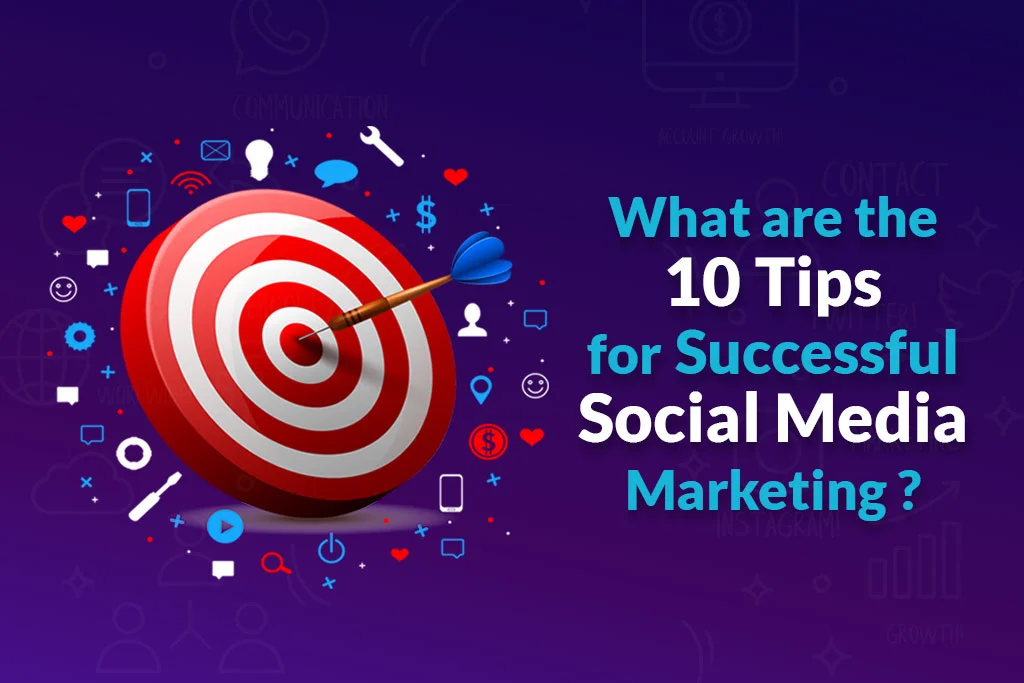What are the 10 Tips for Successful Social Media Marketing?

Are you struggling to get results from your Social Media Marketing efforts? A successful SMM strategy is a necessary component of the whole marketing plan. Using unique methods to communicate with your audience will help you expand your reach. You can use social media analytics tools to measure the effectiveness of your social media marketing activities. You can learn about your target audience’s views on your company. With more than half of the world’s population utilizing social media, businesses must maintain an online presence. It must be accomplished. Businesses use social media to improve their internet presence, get followers, and interact with their target audience.
Tips For Successful Social Media Marketing:

These tips are useful for any business in Social Media Marketing Companies, regardless of size. Even small and medium-sized businesses can use social media to boost their brand visibility. 71% of these businesses use social media to build their presence. Small businesses must pay close attention to their social media activities. Here are some things to remember about Social Media Marketing Companies for small businesses to help them succeed:
- 1. Increase brand awareness among your target demographic.
- 2. Keep track of your competitors’ strategies.
- 3. Engage and build lasting relationships with your valued buyers.
- 4. Stay relevant by participating in current trends.
- 5. Use free social media networks to market and sell your stuff.
1. Create A Strategy:
Your social media businesses also require a carefully planned strategy. Here, we’ll show how to get to your social media marketing strategy in 6 simple steps:
Set Social Media Goals:
Don’t limit your attention to statistics such as likes and shares. Pay attention to generated leads, conversion rates, and website referrals. When setting goals, you need to use the SMART principle. It makes them specific, measurable, attainable, relevant, and time-bound.
Set Up New Accounts, And Complete Existing Ones:
Have you decided which social media platforms are perfect for your small business? Then create an account on each of the social media networks. Check that anything you share there fits with your overall business goals and target audience.
Conduct A Social Media Audit:
First, determine who you’re connected with on social media. Then, find out which networks your target audience uses. And lastly, how does your social media presence compare to the competition?
Create A Social Media Calendar:
The calendar belongs to your essential content marketing strategy. It should include the day and time you want to post on Facebook and Instagram. It also includes tweets and other social media content.
Get Inspiration:
Check out the material that competitors in your industry share. Get an overview and ideas on how to reach out to new customers while standing out from the competition. Discover what makes big companies successful. And, how you might integrate their methods into your social media effort.
Test, Evaluate, And Correct Your Strategy:
Use performance analytics to continuously adjust your plan. Analyze data such as the number of clicks per post, the reach of your actions, and the number of page visits produced by social media. You can utilize this data to improve your plan.
2. Determine Which Platforms Suit You:
You don’t have to be everywhere on social media, but you should make an effect on the networks you use. If your brand works well on Instagram, then put your efforts there rather than spreading yourself out among other media. Quality is more important than quantity. Posting low-quality articles will not benefit you. Research and develop your social media strategy to meet your goals and appeal to your target audience. Concentrate on the platforms that your target audience prefers. This is especially important for small businesses with limited resources. Not every social media site works for your company or its goals. Here, we provide the list of the most popular networks:
- 1. Facebook
- 2. Instagram
- 3. LinkedIn
- 4. Twitter
- 5. Snapchat
- 6. YouTube
- 7. Pinterest
3. Learn About Your Target Audience:
Understanding your target audience is critical in market research. To get their attention, you must first understand who you are trying to reach. Gather information on age, gender, geography, and income to construct audience personas. Creating audience personas is one of the most efficient ways to do successful market research. Here’s how it is done:
- 1. This includes getting information through social media, surveys, focus groups, and customer feedback.
- 2. Analyze the data to identify patterns and trends.
- 3. Then, using these data, construct long profiles of your ideal customers, complete with their names, job titles, and career pathways.
4. Market And Sell Your Products Via Social Media:

Social Media Marketing Agencies are more than simply tweets and Facebook ads. Having a good strategy is critical for attaining the greatest results. The 80/20 Rule states that 80% of your success is due to 20% of your efforts. As a result, the ratio of advertising material across all of your social media channels should be no more than 20%. The remaining 80% interact with your customers. You need to interact with them and share useful content that is valuable to them. Also, make sure you utilize the abilities of each social media network.
5. Create Engaging And Interesting Content:
In a world where social media is loaded with millions of postings. It’s critical to make yours stand out. However, the definition of good content varies by platform. Here are some broad tips for creating engaging content:
Media:
When using static images, make sure they have a clear visual and avoid using too many words. Consider utilizing gifs or movies instead, as movement attracts attention and is more engaging. Don’t forget to highlight your workers. Introducing your team allows your audience to connect with the people behind the company.
Newsworthiness:
You can create content about newsworthy issues is an excellent method to engage your audience. The five pillars of newsworthiness are timeliness, closeness, tension, disagreement, human interest, and relevance. By focusing on these aspects, you can develop engaging content that connects with your target audience.
Trends:
Staying up to date on current digital and societal trends is critical for remaining fresh in today’s fast-paced environment. However, it is equally important to confirm that these trends align with your brand’s values and identity. Staying true to your brand while using relevant trends. It allows you to maintain honesty and connect with your audience.
Storytelling:
Use storytelling to engage your audience and define your brand’s voice. Storytelling is a creative way. You can express your message genuinely without coming across as overly promotional. It allows you to connect with your audience at a deeper level and form genuine relationships.
6. Quality Over Quantity:
While it may be easy to be present on every social media platform to reach a large audience. You should spread yourself too wide and provide little advantage. Quantity frequently costs quality. It results in a concentration on reaching posting quotas rather than providing value. Instead, prioritize quality over quantity by determining where your target audience spends their time. You should try to offer them useful content. Use market research and target audience personas to identify the most successful tools for engaging with your audience. Share information that fits their desires, simplifies their life, or entertains them.
7. Set Up A Social Media Content Calendar:
A strong strategy is essential for successful content marketing on social media. Social media content calendar tools can help you organize and arrange your content more effectively. These technologies can help you speed up your publishing process, boost partnerships, and receive insights about your content’s performance. You may quickly design your calendar using internet templates or scheduling applications such as Media Eclips. With abilities like image publishing and multi-platform scheduling, these technologies make content management easier from a single dashboard. To keep on track with your content strategy, update your calendar every week, create tasks, and easily make changes.
8. Follow Social Media Conversations About Your Business And Respond:
In today’s digital world, social media often replaces face-to-face interactions. It responds quickly to audience questions and humanizes your brand. It shows a genuine interest in their requirements. Failure to engage with your audience might give an impression of disinterest, hurting your business. According to research, more than 80% of customers want companies to respond to social media posts within 24 hours. If you interact with social media, then it allows you to highlight your brand’s personality. Posts with photographs are especially efficient at interacting with your target audience.
9. Use Several Hashtags:
Hashtags are useful for structuring social media posts and generating conversations with your target audience. However, employing too many hashtags could reduce interaction. To avoid this, use only two or three specific hashtags for each post. Concentrate on meaningful, high-volume hashtags that resonate with your target demographic group. You can find these hashtags by using hashtag generators. Keep your hashtags short and relevant to continue engagement and avoid overloading your audience.
10. Track And Analyze Metrics:

Analytics are critical for knowing your target audience and growing your business. They provide insights into what drives traffic. It might help you improve your products and sales forecasts. Social media statistics, which include follower growth, page visits, likes, shares, and clicks, are very useful. MediaEclips provides powerful social media analytics. Its reporting tools help you monitor your success. By reviewing these indicators regularly, you may fine-tune your strategy and make plans. Report exports and scheduled reports allow you to effortlessly share results with your team and clients. This keeps everyone informed and aligned with your social media objectives.
Conclusion:
Social Media Marketing agencies provide numerous benefits for businesses. These include increased brand visibility and better consumer interaction. It also includes more cost-effective promotional techniques, more website traffic, and improved search engine presence. Businesses that utilize the power of social media can effectively reach their target demographic. It builds meaningful connections with customers, and eventually fuels their growth and profitability. No matter which social platforms you use, what sorts of material you share, or how frequently you post, your primary goal should be to improve your Social Media Marketing performance. However, the sheer number of platforms and their various applications can make creating your online identity appear tough. Whether you’re a beginner or a professional, there’s always room for improvement when it comes to building your internet presence. For any query, you can completely rely on MediaEclips, a trusted social media marketing agency in Plano, Tx. If you need to, then you can get a free consultation call with our professionals.
FAQs:
A social media strategy is essential because it provides a road map for businesses to successfully interact with their target audience. It increases brand awareness and achieves their marketing goals.
The target audience for social media varies per platform. But, it usually involves people of various demographics, interests, and behaviors that engage with content and communicate with brands online.

